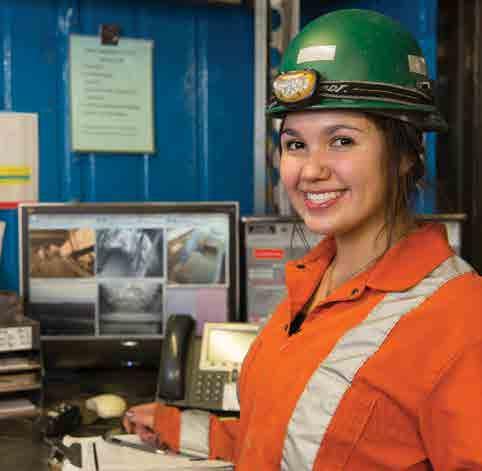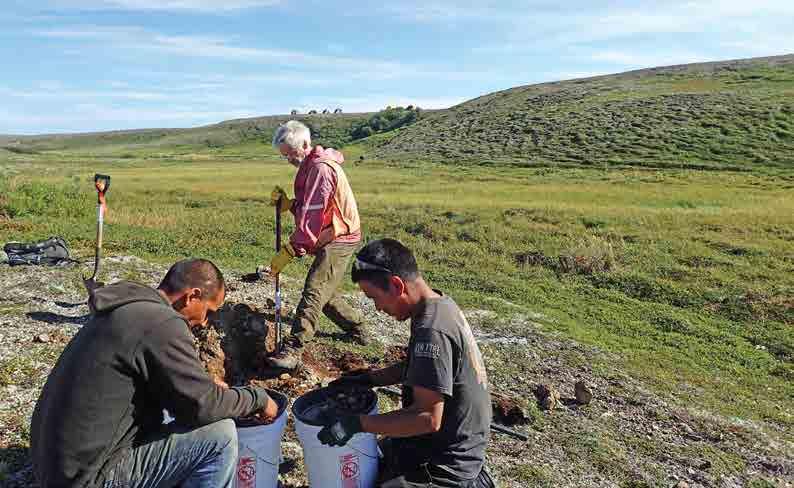
14 minute read
MINING
Scouting for Prospects
The journey from a parcel of land to a fully-functioning mine
By Bruno J. Navarro
Before a patch of land can be developed for mining, its specific location has to be vetted to confirm that it’s an economically feasible place to mine. From start to finish, the process is a long, involved endeavor that requires a significant commitment of time and resources—but the payback can be substantial. In mid-February 2021, a report by McKinley Research Group (formerly McDowell Group) estimated that companies spent $127 million on exploration in Alaska in 2020 and a total of $4 billion since 1981.
The first step toward striking gold (or coal or zinc or… you get the picture) is deciding what commodity is being targeted.
“Ultimately, it’s based on the geology,” says Lance Kilvagiaq Miller, vice president of natural resources for NANA Regional Corporation. For instance, one wouldn’t go looking for copper in Iowa, Miller adds.
“Then you have to look at access, logistics, and if the area is open for mineral entry, or mining,” says Miller, who holds a doctorate in geology and has worked on advanced-stage projects throughout Alaska, as well as Russia, Central Asia, Mexico, and the Canadian Arctic.
One key piece of information for mining companies evaluating their options is the Fraser Institute’s Annual Survey of Mining Companies, most recently published in February 2021. The survey, according to the organization, “is an attempt to assess how mineral endowments and public policy factors such as taxation and regulatory uncertainty affect exploration investment.”
For 2020, the institute sent out approximately 2,200 electronic surveys and received 276, allowing it to evaluate seventy-seven jurisdictions around the world. In the survey, Alaska slipped from fourth place in 2019 to fifth in 2020.
Miller says that the Fraser Institute survey is just one element of a comprehensive look at any given site that includes an understanding of what has “a geologically high potential” for the commodity in demand. “So you need a fundamental understanding of that,” he adds. “Then you look at the political jurisdiction, whether they have a stable government, the permitting and tax regime.”
Next comes site consideration. Once an area’s been established as a potential
site for investment, it’s necessary to determine how mature it is and how much development, if any, has already taken place. “A lot of times, if there’s been a lot of work done, you can conduct desktop work before going into the field,” Miller says.
Alaska’s Department of Natural Resources’ Mineral Resources Section provides a good deal of public information about the state’s geological and geophysical framework to support the mining industry. Other jurisdictions, such as Canada, also maintain extensive public databases of geoscience in the form of geological maps, regional geophysical surveys, and other scientific information. This approach toward public information can save private companies time and effort, says Miller.
After all the initial research is completed, the first boots on the ground are usually geologists or prospectors. Getting that key personnel in place is often determined on a caseby-case process, depending on who owns the land. “If you’re working on private land, clearly you have to have an agreement before you even do exploration,” Miller says. State and federal permitting is a consideration on public lands, too.
Beyond regulatory issues, Miller says mining companies must often work with municipalities, tribal governments, state governments, and local residents.
“Certainly community outreach, communication, consultation, and involvement are critical,” Miller says, adding that projects have stalled in the past due to a failure at this stage.

The Future of Mining
Mining’s prospects appear to be strong for the foreseeable future, Miller says, especially as society slowly inches toward a zero-carbon existence and growing adoption of alternative energy sources.
Miller notes that there are approximately 23 kilograms of copper used in conventional automobiles, a figure that grows to more than 80 kilograms in an electric vehicle. In fact, a February 2021 report by Casey Research estimates copper demand from the auto industry will more than double between 2020 and 2030.

Lance Kilvagiaq Miller, Vice President of Natural Resources, NANA
APPLY NOW FOR LEADERSHIP ANCHORAGE
Founded in 1997, Leadership Anchorage (LA) is the premier leadership development program for established and emerging Alaska leaders seeking to expand their impact in the community.
TRANSFORM YOUR LEADERSHIP
Practice and strengthen essential 21st century leadership competencies including facilitation, coaching, collaboration, and team-building.
AMPLIFY & DIVERSIFY YOUR NETWORKS
Become part of a powerful, diverse community of leaders from a wide range of industries, backgrounds, ages, and experiences.
ACTIVATE IDEAS INTO ACTION
Tackle real, immediate needs within the Anchorage community through team projects partnering with local organizations.
LEADERSHIP
ANCHORAGE Apply now for LA25 at
akhf.org/leadership-anchorage



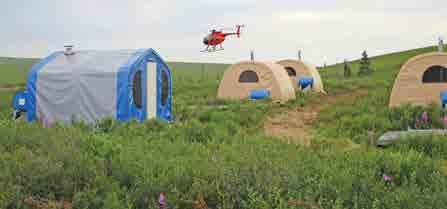
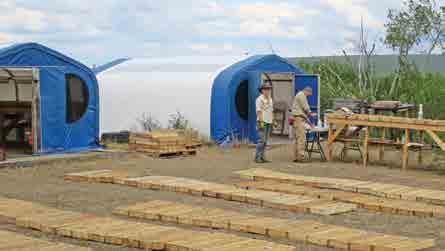
Geologist Varina Zinno performs exploration work in the Alaska Range.
Cat Samson
The growth of future demand for industrial and precious metals has drawn the attention of mining companies and investors. A 2019 report from CME Group, a leading derivatives marketplace, found that demand is outstripping supply. Copper prices rose 440 percent from 2000 to 2011, and aluminum prices doubled from 2000 to 2008—despite greater global supply.
“If you look at what’s needed for base metals in the future, it even outstrips what we’ve mined in the past,” Miller says. “Metals are the basic building blocks of our built society.”
The exploration camp at the Fairhaven Gold Project in Northwest Alaska.
NANA It Starts With Exploration
“The mining cycle begins with exploration,” McKinley Research Group states in a 2018 report. “Following discovery, drilling, sampling, engineering, metallurgical analysis, financial analysis, and baseline environmental analysis are all part of the effort to determine if profitable and environmentally responsible mining is possible. Ore grade, tonnage, and mineral/metal prices are critical factors for mine feasibility, but so are costs.”

CLEAR SPAN

THE UPGRADE CLEAR SPAN BUILDING SYSTEM ™
Whitley’s proprietary clear span system allows for easy install and efficient build time no matter the project! A small crew can erect a 10,000 sq. ft. buildng in just a matter of days with electrical, plumbing, and heating all integrated before shipment to site.
Industries served:
- Logistics - Oil & Gas - Telecom/Utilities - Mining - Transportation - Agriculture
NOW PROUDLY SERVING ALASKA!
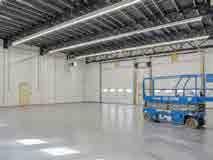



According to Miller, plenty of exploration occurs before work begins at a site.
“It takes 1,500 to 3,000 projects evaluated at a reconnaissance level to come up with one mine. Out of 1,500, you might drill 60 of those,” he says. “You might take five to ten of them to scoping or pre-feasibility. That timeline takes on the order of twenty years and hundreds of millions of dollars in capital spent to get there.”
Miller explains that evaluating a potential mining site involves steps that become more in-depth as the process progresses. “A lot of the same work goes into each stage, just in more and more detail,” he says. All told, it might take two decades or more. “There are a lot of examples in Alaska that have taken longer,” Miller says.
Factors other than geological ones can affect development time, including commodity prices, permitting issues, lawsuits, and the seasonality of work, Miller says.
He cites a study that found “it usually took about seven different companies to look at a property before it became a mine.”
“It is a scientific, geologic process that can lead to new discoveries in places that have been previously looked over,” he adds. “The best place to find a mine is where there’s already a mine.” The Infrastructure Challenge
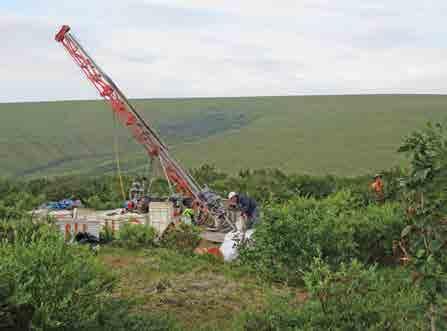
In the Interior, infrastructure costs can quickly add up, particularly in those areas accessible only by air.
“One of the challenges [in Alaska] is the infrastructure,” Miller says. “The cost to develop all that is borne by the project.”



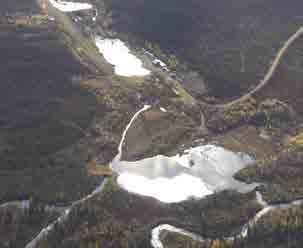

– Evan Polty Jr.
Lead Mechanic, Donlin Gold
Born in Pilot Station and
Resident of Russian Mission
Respectful development for all generations.
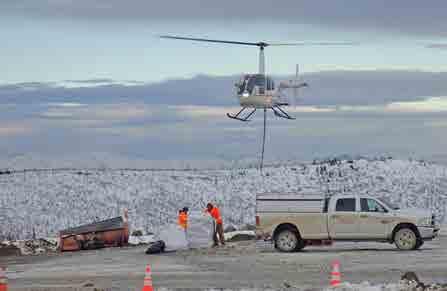
Varina Zinno
It costs significantly more to explore here than it does in other locations such as Australia, Nevada, and Chile, due to remoteness and increased transportation costs. In addition, many projects are supported by helicopter for exploration drilling rather than by roads.
“It’s high-risk, and hopefully, highreturn,” Miller says. “Exploration funding can be erratic based on metals prices and the investors’ perception of the commodity or the jurisdiction.”
All of those factors are combined to gauge a potential project’s overall attractiveness, and stability is a desirable trait. “It’s where there’s a dramatic shift in the regulatory regime or taxation that can be a disincentive,” Miller says.
“If more people understood timing and what goes into a project on the technical side, maybe there would be more appreciation for why it takes so long and how much money it costs,” he adds.
Varina Zinno, who began her career as an independent geologist in Ontario, Canada, and has worked throughout the western United States and across Alaska, emphasizes the iterative nature of exploration—and credits the pioneers upon whose work modern mining relies.
“We basically stand on the shoulders of the explorers, prospectors, and geologists who came before us,” Zinno says. Oftentimes, in the past, a potential mining prospect was discovered by a prospector or a local resident, she adds.
Such discoveries helped spark the 1876 gold rush in Juneau.
When looking at the time it takes for a parcel of land to go from undeveloped to a fully operational mine, the pace can almost appear to be measurable in geological time.
“It can take over 100 years,” Zinno says.
That long time frame can be because an area might have been explored for its placer potential a century ago, but it could take various subsequent stages of work to discover worthwhile lode mineral deposits. “We say that for every 1,000 prospects, only one has what it takes to become a mine.”
In other cases, work can move much more quickly.
Zinno cites Pogo Mine, which lies roughly 135 road miles southeast of Fairbanks. The site, on land owned by the state, was first explored for gold in 1915 along with the broader Goodpaster River region. Interest quickly waned, however, as prospectors turned up largely empty-handed.
Yet in 1991, a regional surface sampling program discovered potential. Zinno says Pogo Mine was permitted by 2004, “and by 2006, ore was arising at the mine.”
“They have a really, really rich gold deposit,” she says, noting that smaller ore deposits drum up less interest and often experience a longer development timeline.
Pogo Mine reached a production milestone in 2020, hitting 4 million ounces of gold.
Whether looking for base metals (such as copper, lead, and zinc), precious metals (such as gold and silver) or rare earth elements, the exploration process follows a similar pattern.
“Exploring the public data from agencies is a good way to begin,” Zinno says, referring to the US Geological Survey and the state DNR’s Division of Geological and Geophysical Surveys.
Zinno says that understanding the geological conditions friendly to various types of mineralization is important, noting that two major fault systems create plenty of possibilities.
“There could be geological structure that plays a role,” she adds. “The Tintina Gold Province in the Yukon runs all the way through Alaska and is bound by two major fault systems.”
Geologists will develop analyses of such traits as geochemical and geophysical data sets and run them through computerized tools like ArcGIS to find potential sites. “That’s how we do targeting,” she says. “After that stage, which can be a desktop study, you go out into the field with boots on the ground to see if you can find evidence of mineralization.”
Geologists can determine the likelihood of mineral deposits in greenfields—or undeveloped areas—as well as brownfields, which are areas that contain “waste rock that was already mined years ago, or next to mines but not fully explored,” Zinno says, adding that scientific understanding of the underlying geological conditions may have changed, or there is new information to consider.
Zinno says that aerial surveys for geophysics—which aren’t always easy to conduct—are another commonly used tool.
“The weather affects it a lot. The remoteness affects it a lot because it’s very expensive,” she says. “Equipment and crew may have to travel a very long way, and they might have to set up a site camp.”
Weather delays can sometimes hinder up to 20 to 30 percent of flights, as well as surveys that are affected by cloud cover or snow cover.
“You really have to work for it in Alaska,” Zinno says. Budget considerations for such logistical challenges can be so significantly
higher relative to other expenses “that I think outside financing companies get sticker shock at first.”
Still, the possibility of making a big discovery has meant increased activity in the state from Australian companies seeking new investment opportunities around the world. Miners from Down Under have now overtaken Canadian as the most active Outside mining companies in Alaska.
Reportedly, Australian mining companies—South32, Northern Star, Nova Minerals, and four others—are expected to invest nearly $100 million in Alaska mining and mineral projects beginning in 2020.
And it’s not surprising, the lure is undeniable.
Alaska holds the world’s second-largest reserves of coal, or approximately 12 percent of the global supply, according to the state Department of Natural Resources’ Division of Geological and Geophysical Surveys. Alaska holds 3.5 percent of the world’s zinc (7th globally), 3 percent of the world’s gold (10th spot worldwide) and 2 percent of the world’s lead (11th globally).
An increasingly important element of the process today comes in the form of environmental, social, and governance (or ESG) considerations, Miller says, making it crucial that mining companies emphasize the social purpose of their projects in addition to exploration efforts.
“The importance of ESG is critical,” according to Miller. “And also because the investment community is demanding that projects have a positive societal impact. BlackRock puts that right up front.”
In recent years, BlackRock—the world’s largest asset manager—has emphasized the need for better practices and public education. In fact, BlackRock CEO Larry Fink wrote in a 2021 letter to investors, “It’s not just that broad-market ESG indexes are outperforming counterparts. It’s that within industries, from automobiles to banks to oil and gas companies, we are seeing another divergence: companies with better ESG profiles are performing better than their peers, enjoying a ‘sustainability premium.’”
Miller notes that the concerns around ESG mirror an earlier trend known as the “triple bottom line,” sometimes known as TBL or 3BL, that takes into account people and the planet, as well as profit.
“It’s not just all about profit. It is a way to think about things, with sustainability representing intergenerational wellbeing,” Miller says, making it clear that mining is a critical component of society and the economy.
Similarly, Zinno emphasizes that it’s important for the general public to understand that the metals and minerals extracted from the ground are absolute necessities in the day-to-day lives of modern society.
“There’s really a big disconnect, but Alaska mining is sustainable and ethical mining,” she says, crediting the state’s environmental protections.
“It takes a few extra years at the end to go through the permitting process, and that’s really important because that’s the mechanism through which Alaska does sustainable mining,” Zinno says. “We’re really proud of the robust permitting process that regulates it and keeps it safe for everyone.”
Better Mining. Better World.
At Teck, we know that how we mine is just as important as what we mine. That’s why sustainability is central to how we responsibly provide the metals and minerals needed for today’s modern world.
